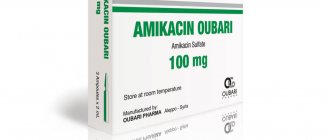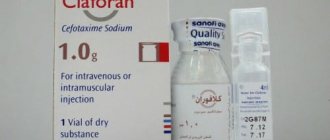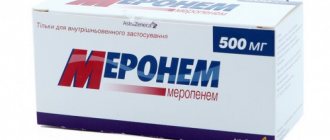pharmachologic effect
Cefoperazone + Sulbactam is a combination drug.
Cefoperazone is a broad-spectrum antibiotic It affects aerobic and anaerobic bacteria and is resistant to many beta-lactamases of microorganisms.
Sulbactam is an irreversible beta-lactamase . It prevents the destruction of penicillins and cephalosporins . Binds to penicillin-binding proteins exhibits synergism when combined with penicillins and cephalosporins .
Pharmacodynamics and pharmacokinetics
The combination of sulbactam and cefoperazone affects bacteria sensitive to cefoperazone . It acts synergistically against Escherichia coli, Staphylococcus spp., Proteus mirabilis, Enterobacter aerogenes, Morganella morganii, Bacteroides spp., Enterobacter cloacae, Acinetobacter calcoaceticus, Klebsiella pneumoniae, Citrobacter freundii, Haemophilus influenzae, Citrobacter diversus.
Cefoperazone affects microorganisms by inhibiting the biosynthesis of bacterial cell wall mucopeptide
Sulbactam promotes the activity of cefoperazone against resistant microorganisms that produce beta-lactamases .
The degree of binding of cefoperazone plasma proteins is about 85%, sulbactam - 38%.
The half-life of cefoperazone is approximately 2 hours, sulbactam - 1 hour. Cefoperazone is excreted in the urine within 8 hours.
In case of liver dysfunction, serum and urinary elimination time are increased.
Instructions:
Clinical and pharmacological groups
06.012 (III generation cephalosporin with beta-lactamase inhibitor) 06.010 (III generation cephalosporin)
pharmachologic effect
Broad-spectrum cephalosporin antibiotic of the third generation. It has a bactericidal effect by inhibiting the synthesis of bacterial cell walls. Cefoperazone acetylates membrane-bound transpeptidases, disrupting the cross-linking of peptidoglycans necessary to ensure cell wall strength and rigidity.
Active against aerobic, anaerobic, gram-positive and gram-negative bacteria, as well as against Pseudomonas aeruginosa.
Resistant to most β-lactamases.
Pharmacokinetics
Plasma protein binding is 82-93%. Distributed in tissues and body fluids, reaching Cmax in bile after 1-2 hours. It penetrates poorly through the blood-brain barrier, penetrates the placental barrier, and is excreted in breast milk. Excreted in bile. Up to 30% of the dose is excreted unchanged in the urine within 12-24 hours.
Dosage
Administer intravenously or intramuscularly.
A single dose for intravenous administration for adults is 1-4 g/day, the interval between administrations is 12 hours. Depending on the etiology of the disease, intramuscular administration of 500 mg is possible once.
Children - 50-200 mg/kg/day, frequency of administration - 2 times/day.
The maximum daily dose for adults is 12 g.
Drug interactions
Cefoperazone, by suppressing intestinal flora, prevents the synthesis of vitamin K. Therefore, when administered simultaneously with drugs that reduce platelet aggregation (NSAIDs, salicylates, sulfinpyrazone), the risk of bleeding increases. For the same reason, when used simultaneously with anticoagulants, an increase in the anticoagulant effect is observed.
Use during pregnancy and lactation
Contraindicated for use during pregnancy and lactation (breastfeeding).
Side effects
From the digestive system: nausea, vomiting, diarrhea, transient increase in the activity of liver transaminases, cholestatic jaundice, hepatitis, pseudomembranous colitis.
Allergic reactions: skin rash, itching, eosinophilia; rarely - Quincke's edema.
From the hematopoietic system: with long-term use in high doses, changes in the peripheral blood picture are possible (leukopenia, neutropenia, thrombocytopenia, hemolytic anemia).
From the blood coagulation system: hypoprothrombinemia.
From the urinary system: interstitial nephritis.
Effects due to chemotherapy: candidiasis.
Local reactions: phlebitis (with intravenous administration), pain at the injection site (with intramuscular administration).
Indications
Infectious and inflammatory diseases caused by microorganisms sensitive to cefoperazone, incl. diseases of the upper and lower respiratory tract, infections of the genitourinary system, peritonitis, cholecystitis and other abdominal infections, sepsis, meningitis, infections of the skin and soft tissues, infections of the pelvic organs.
Prevention of infectious complications after abdominal, gynecological, cardiovascular and orthopedic surgeries.
Contraindications
Severe renal failure, pregnancy, lactation, hypersensitivity to cephalosporins and other beta-lactam antibiotics.
special instructions
Cefoperazone is used with caution in case of liver dysfunction (with simultaneous impairment of liver and kidney function, dose adjustment is necessary), as well as in patients with a history of bleeding.
In patients with hypersensitivity to penicillins, allergic reactions to cephalosporin antibiotics are possible.
During the period of use of cefoperazone, a false positive reaction of urine to glucose is possible.
During treatment with cefoperazone, you should avoid drinking alcohol, because it is possible to develop effects similar to those of disulfiram (abdominal cramps, nausea, vomiting, headache, hypotension, shortness of breath, tachycardia).
Preparations containing CEFOPERAZONE
• SULPERACEF® powder for preparation. solution d/iv and i/m injection. 1 g+1 g: fl. 1 or 5 pcs. included with or without solvent • CEFOPERAZONE powder for preparation. solution for intravenous and intramuscular administration of 1 g: fl. 1, 10 or 50 pcs. • CEFOPERABOL® powder for preparation. solution for intravenous and intramuscular administration of 1 g: fl. 1 or 5 pcs. included with or without solvent • SULCEF powder for preparation. solution for intravenous and intramuscular administration of 1 g+1 g: vial. 1 or 100 pcs. • CEFOPERAZONE & SULBACTAM SPENSER powder for preparation. solution d/iv and i/m injection. 1 g+1 g: fl. 1 PC. • CEFOPERAZONE powder for preparation. solution for intravenous and intramuscular administration of 500 mg: vial. 1, 10, 25 or 50 pcs. • SULZONCEF® powder for preparation. solution for intravenous and intramuscular administration of 1 g+1 g: vial. 1, 5, 10 or 50 pcs. • CEFOPERAZONE powder for preparation. solution for intravenous and intramuscular administration of 1 g: fl. 1, 10, 25 or 50 pcs. • CEFOPERUS® powder for preparation. solution for intravenous and intramuscular administration of 1 g: fl. 1, 5 or 10 pcs. • CEFPAR (CEFPAR) powder for preparation. solution for intramuscular and intravenous administration of 2 g: fl. 1 or 50 pcs. • MOVOPERIZ powder for preparation. solution for intravenous and intramuscular administration of 1 g: fl. 10 pieces. • CEFOPERABOL® powder for preparation. solution for intravenous and intramuscular administration of 500 mg: vial. 1 or 5 pcs. in the computer with or without solvent • CEFOPERAZONE powder for preparation. solution for intravenous and intramuscular administration of 500 mg: vial. 1 PC. • CEFOPERUS® powder for preparation. solution for intravenous and intramuscular administration of 2 g: fl. 1, 5 or 10 pcs. • CEFPAR (CEFPAR) powder for preparation. solution for intramuscular and intravenous administration of 1 g: fl. 1 or 50 pcs. • CEFOBID® (CEFOBID®) powder for preparation. solution for intravenous and intramuscular administration of 1 g: fl. 1 PC. • SULPERACEF® powder for preparation. solution d/iv and intramuscular injection. 500 mg+500 mg: vial. 1 or 5 pcs. included with or without solvent • CEFOPERAZONE-AGIO powder for preparation. solution for intravenous and intramuscular administration of 1 g: fl. 1, 10 or 50 pcs. • SULCEFAZON powder for preparation. solution for intravenous and intramuscular administration 250 mg + 250 mg: vial. 1, 5, 10 or 50 pcs. • SULMOVER powder for preparation. solution d/iv and intramuscular injection. 1 g+1 g: fl. 1 or 10 pcs. • MEDOCEF powder for preparation. solution for intravenous and intramuscular administration of 2 g: fl. 1, 10, 25, 50 or 100 pcs. • SULCEFAZON powder for preparation. solution for intravenous and intramuscular administration of 500 mg+500 mg: vial. 1, 5, 10 or 50 pcs. • TSEBANEKS (CEBANEX) powder for preparation. solution d/iv and intramuscular injection. 500 mg+500 mg: vial. 1 PC. • CEFPAR (CEFPAR) powder for preparation. solution for intramuscular and intravenous administration 500 mg: vial. 1 or 50 pcs. • MEDOCEF powder for preparation. solution for intravenous and intramuscular administration of 1 g: fl. 1, 10, 25, 50 or 100 pcs. • BACPERAZONE powder for preparation. solution for intravenous and intramuscular administration 250 mg + 250 mg: vial. 1 PC. • CEFOPERAZONE J powder for preparation. solution for intravenous and intramuscular administration of 1 g: fl. 1, 10, 25, 48 or 100 pcs. • CEPHPAR SV powder for preparation. solution d/iv and intramuscular injection. 500 mg+500 mg: vial. 1 or 50 pcs. • SULPERASON powder for preparation. solution d/v/v and i/m introduced. 1 g+1 g: fl. 1 PC. • CEFOPERABOL® powder for preparation. solution for intravenous and intramuscular administration of 2 g: fl. 1 or 5 pcs. included with or without solvent • CEFOPERAZONE powder for preparation. solution for intravenous and intramuscular administration of 2 g: fl. 1, 10, 25 or 50 pcs. • CEFOPERAZONE & SULBACTAME JODAS powder for preparation. solution d/iv and intramuscular injection. 1 g+1 g: fl. 1 PC. • BACPERAZONE powder for preparation. solution for intravenous and intramuscular administration of 1 g+1 g: vial. 1 PC. • CEFOPERUS® powder for preparation. solution for intravenous and intramuscular administration of 500 mg: vial. 1, 5 or 10 pcs. • CEFOPERAZONE-VIAL powder for preparation. solution for intravenous and intramuscular administration of 1 g: fl. 1 PC. • SULCEFAZON powder for preparation. solution for intravenous and intramuscular administration of 1 g+1 g: vial. 1, 5, 10 or 50 pcs. • OPERAZ powder for preparation. injection solution 1 g: fl. 1 or 100 pcs. • BACPERAZONE powder for preparation. solution for intravenous and intramuscular administration of 500 mg+500 mg: vial. 1 PC. • CEPHPAR SV powder for preparation. solution for intravenous and intramuscular administration of 1 g+1 g: vial. 1 PC. • DARDUM powder for preparation. solution for intramuscular and intravenous administration of 1 g: fl. 1 or 100 pcs. • CEFOPERAZONE J powder for preparation. solution for intravenous and intramuscular administration of 2 g: fl. 1, 10, 25, 48 or 100 pcs. • SULPERACEF® powder for preparation. solution d/iv and intramuscular injection. 250 mg+250 mg: vial. 1 or 5 pcs. included with or without solvent
Indications for use
The drug Cefoperazone + Sulbactam is used for urinary tract infections, respiratory tract infections, intraperitoneal infections, skin infections, osteomyelitis , sepsis , soft tissue infections, joint infections, ENT infections, meningitis .
The medicine is also prescribed for the prevention of infectious complications after orthopedic , abdominal , gynecological and cardiovascular surgeries .
special instructions
Due to the increased risk of bleeding, Cefoperazone + Sulbactam should be administered with caution to weakened patients with malabsorption, as well as when drinking alcohol.
In cases of superinfection, appropriate treatment is required.
If allergic reactions develop, therapy should be discontinued immediately and appropriate treatment should be prescribed. Severe anaphylactic reactions require immediate emergency treatment (eg, adrenaline). According to indications, oxygen therapy, intravenous corticosteroids can be used, and airway patency, including intubation, must be ensured.
In some patients, the use of cefoperazone leads to the development of vitamin K deficiency. The risk group includes patients with limited nutrition, malabsorption (for example, with gallbladder fibrosis), as well as patients who have been on parenteral (intravenous) nutrition for a long time. Such patients require monitoring of prothrombin time. Similar monitoring is necessary for patients using anticoagulants. In such cases, additional administration of exogenous vitamin K is possible.
As with the use of other antibiotics, long-term treatment with Cefoperazone + Sulbactam can lead to increased growth of resistant microflora. In this regard, the patients' condition must be closely monitored. It is necessary to take into account the likelihood of periodic manifestations of disorders of the kidneys, liver and hematopoietic system. This caution especially applies to the treatment of newborns (including premature infants).
Side effects
Taking the drug Cefoperazone + Sulbactam can lead to the following adverse reactions:
- urinary system: hematuria ;
- CVS: vasculitis , arterial hypotension ;
- circulatory system: decreased hemoglobin hematocrit level , positive direct Coombs test , thrombocytopenia , eosinophilia , hypoprothrombinemia , leukopenia ;
- CNS: decreased albumin , bilirubin encephalopathy (in the case of treatment of newborns with jaundice );
- Gastrointestinal tract: diarrhea , vomiting, nausea, pseudomembranous colitis ;
- skin: Stevens-Johnson syndrome , urticaria , pruritus , maculopapular rash ;
- changes in laboratory parameters: increased liver function tests ;
- local reactions: pain at the injection site, phlebitis at the injection site during infusion through an intravenous catheter ;
- other: anaphylactic reactions , headache , fever , muscle twitching.
Instructions for use Cefoperazone + Sulbactam (Method and dosage)
The medicine is used intravenously or intramuscularly. For adults, daily dosages of 2-4 g are indicated. They are divided into several doses with an interval of 12 hours. If the infection is severe, the daily dosage can be increased to 8 g.
For chronic renal failure, it is necessary to take medications 2 times a day in the following dosages:
- creatinine clearance 15–30 ml/min – up to 1 g is prescribed;
- creatinine clearance up to 14 ml/min – 500 mg is prescribed.
Children are shown daily doses of 40-80 mg/kg. The daily dosage is divided into 2-4 doses. In case of severe infections, up to 160 mg/kg can be prescribed. If it is necessary to administer more than 80 mg/kg, the daily dose is increased by additional of cefoperazone
Instructions for use Cefoperazone + Sulbactam states that for intravenous administration the medicine is diluted in sterile water for injection, Dextrose 5% or sodium chloride 0.9%. The drug is administered within three minutes. In the case of intravenous infusion, the drug is diluted in 20-100 ml of solution and administered for 15-60 minutes.
When administered intramuscularly, the drug is diluted in sterile water for injection.
If Lidocaine , the drug is diluted in 2 stages: first, this is done with sterile water, and then with a 2% solution of Lidocaine until a 0.5% solution of Lidocaine . In this case, the total volume of the solvent is 6.7 ml.
Interaction
It is advisable not to combine with alcohol and products containing ethanol, including within 5 days after the course of the drug. Otherwise, negative reactions such as facial redness, headache , sweating , and tachycardia .
When using the drug Cefoperazone + Sulbactam, an erroneously positive reaction to glucose in the urine is possible if or Fehling's solution .
Overdose
Main symptoms: increased side effects. It must be taken into account that at high concentrations of beta-lactam antibiotics in the cerebrospinal fluid, neurological reactions, in particular seizures, may develop.
Cefoperazone and sulbactam are removed from the circulation by hemodialysis, so this procedure may lead to increased elimination of the drug from the body in case of overdose in patients with impaired renal function.
Therapy: symptomatic. There is no specific antidote.







